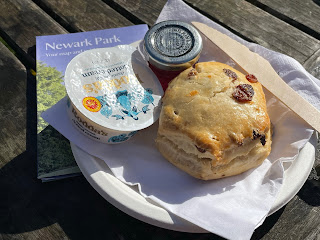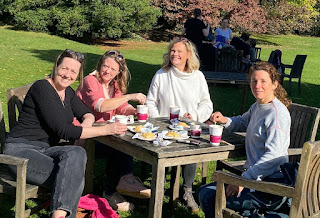Leith Hill Place in Surrey probably wouldn't win any awards for architectural beauty. But it would be a strong contender for the award of Highest Number of Famous People Connected to a Single National Trust Property.
In one building, Leith Hill Place attempts to explain the lives and achievements of three highly distinguished people:
- Josiah Wedgwood
- Charles Darwin
- Ralph Vaughan Williams
The Wedgwoods
Let's start with Josiah Wedgwood. Josiah joined his family pottery business in 1744 but in 1759 he set up on his own, determined to do something different with ceramics. His first innovation was creamware (also known as queensware after Queen Charlotte ordered a set). Creamware became an acceptable alternative to porcelain.
But it's jasperware that is most recognisable as a Wedgwood innovation. Seen below, jasperware involved a matt finish in many shades, with relief decorations in white and other contrasting colours. The moral of the story of Josiah Wedgwood is perseverance - it took 5000 experiments to get jasperware right.
The Darwins
Josiah Wedgwood was great friends with the physician and naturalist, Erasmus Darwin. Eventually, Josiah's daughter Susannah married Erasmus's son Robert. Their children included Charles Darwin (who married his cousin, Emma Wedgwood) and Caroline Darwin (who married Emma's brother Josiah).
Caroline and Josiah bought Leith Hill Place in 1847 - it was Caroline who planted the rhododendron wood. The couple had several children who grew up at Leith Hill. One of those children was Margaret Wedgwood, who married Arthur Vaughan Williams. They moved to Gloucestershire, where Ralph Vaughan Williams was born, but Arthur died when Ralph was only three and Margaret moved her family back to Leith Hill. Margaret stayed at the house until she died in 1937.
Ralph Vaughan Williams
It's actually Ralph (pronounced Raif) Vaughan Williams who gets top billing at Leith Hill Place.
- He was born in 1872
- He started learning piano at the age of five, composing his first piece at six
- He studied at Trinity College Cambridge, and at the Royal College of Music
- In 1901, he published his first composition, Linden Lea
- The Lark Ascending, one of his most famous pieces, was written in 1914 but he decided to enlist in the Royal Medical Corps and went off to war. It was first performed in 1920.
- He was awarded the Order of Merit in 1935, having declined a knighthood
- He died in 1958 and his ashes are interred at Westminster Abbey
There's a whole room dedicated to his life and times, and his major works are all listed. I'd studied a piece of RVW music at school but I didn't recognise it in the list. I later worked out that we'd covered
The March Past of the Kitchen Utensils, which he composed in 1909. I remain confused as to why we studied something that doesn't even warrant a passing mention at Leith Hill but it's not the first time my education has been found wanting.
His very unassuming practice piano has been returned to Leith Hill Place and if you're a professional pianist they might let you play it.
Ralph's brother Hervey inherited Leith Hill Place from their mother but when he died, it passed to Ralph who gave it to the National Trust. RVW's cousin and friend, Sir Ralph Wedgwood, lived at the property before it became a boarding house for a school.
The cellar
The signs pointing down to the cellar were a bit ominous - 'go down if you dare' being the general message. But it was OK - the warnings referred to the lack of a handrail and the presence of a few spiders.
However, apart from the spiders the contents were very unexpected - it would have taken me 10 years to predict what I'd find in there and I'd still have failed. The walls are covered in murals painted in the 1960s by some friends of the Wedgwoods. The paintings are copies of those found at Knossos, an archaeological site on the Greek island of Crete. Coincidentally, I visited Knossos in October last year - you can read about that
trip to Knossos on my other blog.
Another item for the list of "Things You Really Didn't Expect to Find at the National Trust".
The Leith Hill Place Scone
If it's a scone-with-a-view you're after, then Leith Hill Place is for you. The tea room is inside the house, in what used to be the kitchen, with beautiful views over Surrey.
My companions today were my sister-in-law, Thelma, and niece, Fay, who have had mixed fortunes on this quest. They loved the town of Rye and
Lamb House but were surprisingly harsh on the scones.
Croft Castle got a unanimous 5 out of 5 for everything, as did
Mottistone Gardens on the Isle of Wight. And then this year Fay was with me at
Hatfield Forest for the rare no-scone situation that we won't go into here.
Today the verdict was unanimously positive once again. The tea was served in bone china cups, they had decaffeinated tea, the kitchen warmed up the scones as requested, and they were very tasty. A triumph in another property where the facilities are relatively limited but the staff do a fantastic job.
It's also possible to sit outside and enjoy your scones and tea, overlooking the spectacular view - recommended although maybe not in a downpour like we had today:
I'm going to end with a big thank you to Laura, the brave Sconepal who contacted me on Twitter to tell me that I had missed Leith Hill Place from my list. I had been to
Leith Hill in 2015 but Leith Hill and Leith Hill Place are different properties. If you know of any other hidden National Trust properties, let me know!
Leith Hill Place: 5 out of 5
Scone: 4.5 out of 5
Brave Sconepals saving the day: 5 out of 5
















